The Scottish Investment Trust (SCIN) seeks to ignore the ‘madness of crowds’ and invest in deeply unloved areas of the global stock market, where recovery potential has been overlooked by the majority of investors. Absolute returns have been strong year to date (1 January to 31 August 2019), with share price and NAV total returns of more than 10%. However, performance has lagged the strong rebound in global indices, which have been driven by a relatively narrow range of highly valued stocks. Manager Alasdair McKinnon is backing areas including gold miners (the outlook for gold is positive given lax monetary and fiscal policy against a worsening economic backdrop, yet miners have remained out of favour) and telecoms, which offer limited economic sensitivity and attractive dividend yields.
Five years of value underperformance – when will the cycle turn?
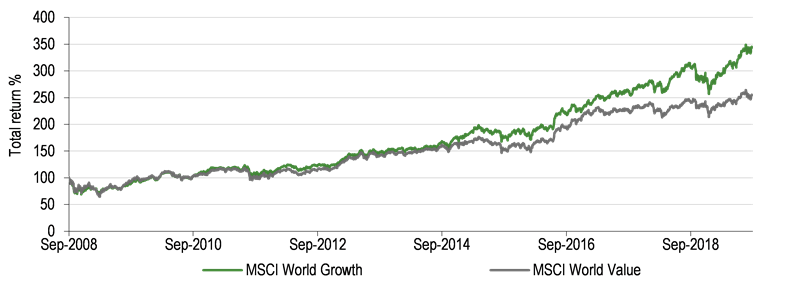
The market opportunity
For the past five years (see chart above), global investors have preferred higher-valued growth stocks to those trading at cheaper valuations. It is very unusual for growth to outperform value for such an extended period, and with stock markets around the world trading at high levels relative to history, and the economic backdrop worsening, investors with an eye to long-term gains may be better rewarded in future by backing areas that are not currently ‘priced for perfection’.
Why consider investing in The Scottish IT?
Highly differentiated ‘global contrarian’ investment approach, designed to anticipate and benefit from change, while limiting downside risk by investing in stocks at low valuations.
35-year record of annual dividend growth, aiming to grow ahead of UK inflation.
Active discount control policy, supported by buybacks and marketing activity.
One of the lowest-cost trusts in the AIC universe.
Stable discount and growing dividends
At 27 September 2019, SCIN’s shares traded at an 8.7% discount to cum-fair NAV. An active buyback policy seeks to limit the discount at c 9.0%, and its effectiveness is evident in average discounts of 9.0% and 9.3% over one and three years. Dividends are paid quarterly and the shares currently have a yield of 3.0% (including the FY18 special dividend).
Share price/discount performance

Three-year performance vs index
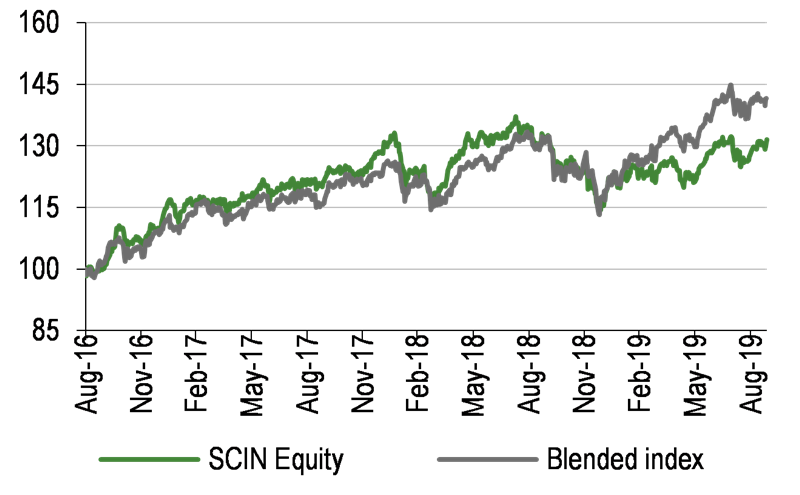
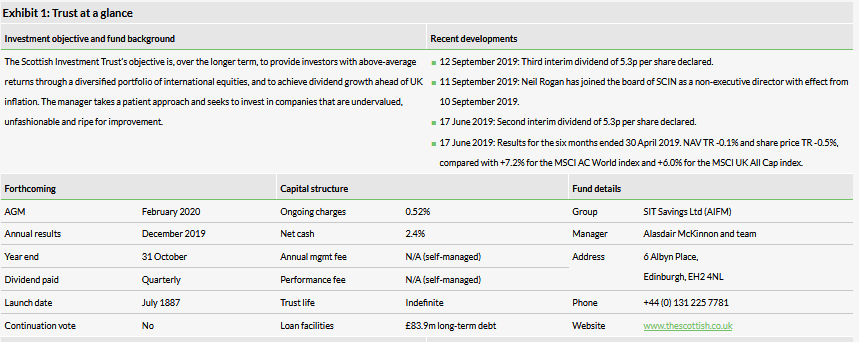
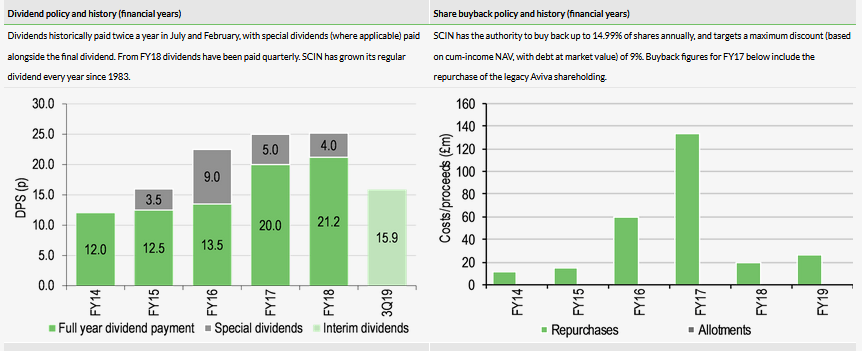
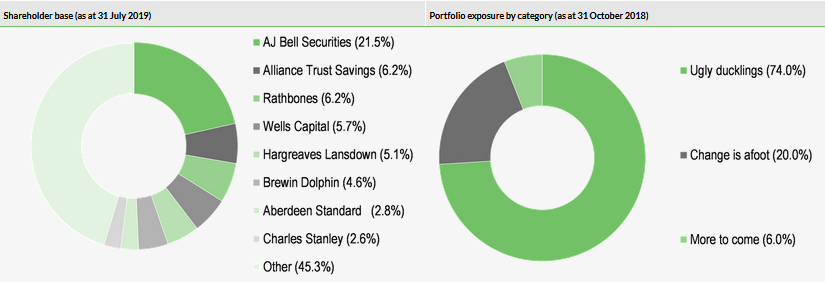
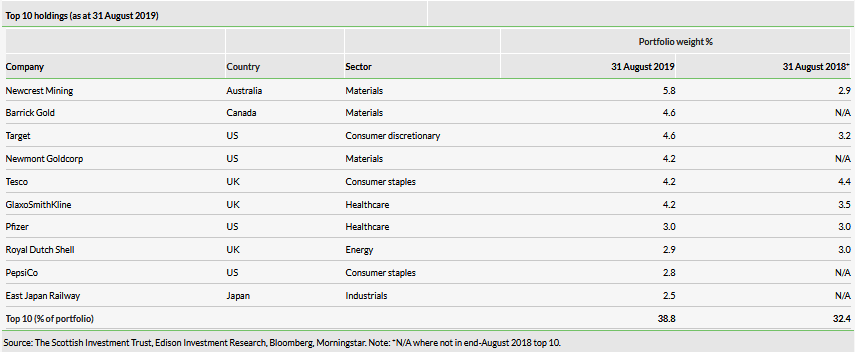
Market outlook: Hot stocks continue to defy gravity

Global stock markets have bounced back sharply from the sell-off at the end of 2018, supported in large part by the decision of the US Federal Reserve first to pause in its cycle of interest rate rises, and then to implement its first rate cut in more than a decade. Given the reasoning behind the policy reversal was a worsening global economic backdrop, it could be argued that the ‘bad news is good news’ reaction of investors has been over-optimistic, particularly in light of the continued trade dispute between the US and China, which has potential to cause economic pain to both nations. Many leading indicators – from manufacturing and consumer sentiment indices to government bond yields – are now also suggesting an economic downturn, yet markets have continued to be led upwards by a relatively narrow range of highly valued stocks that have already performed well (examples include ‘big brand’ consumer names and technology stocks), while those that have been out of favour continue to lag. With the gap between ‘growth’ and ‘value’ at levels that look very extended in a historical context (see front page chart), investors who wish to retain equity market exposure could be well served in the long term by taking a more contrarian view. However, although it seems reasonable to assume that at some stage there will be a rotation from growth to value, the timing of such a move is harder to call. As economist John Maynard Keynes is reputed to have remarked, ‘the market can remain irrational longer than you can remain solvent’, and investors should be prepared to take a patient, long-term approach to unlocking hidden value.
Fund profile: Active global contrarian
The Scottish Investment Trust is a self-managed global investment trust, headquartered in Edinburgh since its launch in 1887. Manager Alasdair McKinnon and his four-strong investment team follow a high-conviction, contrarian investment process, seeking to identify those companies whose potential for share price growth and recovery has been overlooked by the wider market, and then holding the shares until other investors have begun to recognise their value. The trust’s objective is to provide longer-term capital appreciation and above-inflation annual dividend growth.
McKinnon and the team follow a disciplined process to build a ‘best ideas’ portfolio of c 50–100 stocks from around the world, which are out of favour and have the potential to re-rate over time as a result of operational and/or cyclical improvements. The investment style is unconstrained and the trust does not have a formal benchmark, although it uses the MSCI AC World and MSCI UK All-Cap indices in its literature, to provide context to its performance. SCIN is a member of the Association of Investment Companies’ Global sector.
Gearing is permitted up to 20% of net assets; SCIN has structural gearing of c £84m (c 12.0% gross), but uses cash flexibly to offset this according to the manager’s assessment of market conditions, and currently has net cash of 2.4%. Dividends have grown year-on-year in each of the last 35 financial years.
The fund manager: Alasdair McKinnon
The manager’s view: Glittering prizes in the gold mining sector
As a contrarian investor, McKinnon avoids the ‘concept’ stocks that have traded up to high levels against a market backdrop continually supported by fresh injections of cheap money as a result of loose monetary policy. ‘These areas of the market look concerning to us’, he says, drawing parallels with the internet bubble of the late 1990s when companies that merely added ‘.com’ to their name would immediately see a positive share price reaction. The manager argues that the establishment is ‘responding to the wrong signals’ by shoring up an overheated market with even more, cheaper money, leading to significant downside risk in ‘hotter’ areas of the market such as US and Chinese technology stocks. In contrast, says McKinnon, ‘real world’ stocks have been in a bear market for at least 18 months, with more economically sensitive areas of the market pricing in quite a harsh environment.
Partly because of the deteriorating global economic picture, McKinnon currently favours gold as an asset class, describing it as ‘the only honest source of money that exists’. He has chosen to get exposure to gold via mining companies, which he says have been out of favour for the best part of 20 years, largely because of the introduction of gold ETFs, which made it easy for investors to access the asset class when previously it had been less so. The manager argues that the rise of populist politics – with the attendant loss of fiscal prudence – makes gold look more attractive as a store of value against a backdrop where ballooning deficits could see national currencies devalued and inflationary pressures emerging. He points out that in addition to liking the outlook for gold as an asset, gold mining companies have begun to take serious measures to justify their position as investments, such as mergers between some of the major players in order to create cost synergies. SCIN holds three gold mining companies, all of which are among its top five holdings; they have performed well year to date and have been among the principal contributors to the trust’s returns.
Elsewhere in the market, McKinnon continues to find opportunities in unloved areas of the market – ‘stocks that are really overlooked and pricing in a lot of bad news’. These include many telecom companies (see Current positioning), which offer reasonable yields and limited economic sensitivity, as well as their shares being attractively valued.
Asset allocation
Investment process: Investing away from the herd
SCIN’s manager Alasdair McKinnon follows an active contrarian investment approach, seeking out undervalued opportunities and taking advantage of volatility and market uncertainty. The process is based on the theory of behavioural finance, and aims to exploit the natural tendency of investors to ‘follow the herd’, chasing returns from stocks that have already performed well, while other areas of the market remain largely ignored. McKinnon and the rest of the SCIN investment team – deputy manager Martin Robertson, investment managers Sarah Monaco and Mark Dobbie, and investment analyst Igor Malewicz – actively seek out stocks in unpopular areas that have the potential to recover and grow. They assign companies to one of three categories:
Ugly ducklings – very out-of-favour companies where poor investor perception is coupled with operational challenges, but which have positive potential. Current examples in the SCIN portfolio include US clothing retailer Gap (which has plans to split out its mass-market Old Navy division and close unprofitable flagship Gap stores), UK healthcare giant GlaxoSmithKline (also planning a split into consumer health and pharmaceutical/vaccines divisions), UK supermarket group Tesco (LON:TSCO), and Australian gold miner Newcrest Mining (currently SCIN’s largest holding).
Change is afoot – stocks where operational improvements are beginning to take effect, but which remain overlooked by the majority of investors. Examples include US retailer Target (NYSE:TGT) and US pharmaceutical company Pfizer (NYSE:PFE).
More to come – a small part of the portfolio, these are usually stocks that have moved up through the other categories and are now more favoured by the market, but still offer underappreciated growth prospects.
The investment process is disciplined and clearly articulated, with idea generation from a variety of internal and external sources, fundamental analysis, and team-based discussion of potential purchases. New holdings tend to come into the portfolio at 0.5–3.0% of the total, with position size based on conviction. The team looks for a combination of potential for improvement (for example, being at a cyclical low point in industry or earnings terms, or at the start of a strategic turnaround plan), poor investor sentiment, and downside protection (for example, cash-generative companies with strong balance sheets that are able to weather a cyclical downturn). Stocks may be sold if the cyclical and operational position improves to the point where investors are more optimistic and there is little margin for error; at this stage, there are likely to be more attractive investment opportunities elsewhere.
The contrarian approach requires patience, and SCIN’s portfolio turnover tends to be relatively low as a result (19.8% in FY18, implying an average holding period of around five years).
Current portfolio positioning

At 31 August 2019, there were 50 holdings in SCIN’s equity portfolio, with the top 10 making up 38.8% of the total. This was an increase in concentration compared with 32.4% a year earlier. In line with McKinnon’s positive view on the outlook for gold, three of the top four stocks are gold mining companies – Newcrest Mining, Newmont Goldcorp and Barrick Gold, together accounting for 14.6% of the portfolio. The manager has added substantially to holdings in this area over the past 12 months, and materials is now the largest sector weighting (Exhibit 3), up by 8.3pp (adjusted for cash) since 31 August 2018.
The weighting in communications services has also increased significantly, largely as a result of the addition of five new telecom stocks to the portfolio since the start of the year. Four of them – KPN, Deutsche Telekom (DE:DTEGn), Orange and Tele2 – are based in Europe, while the fifth is Australian operator Telstra. McKinnon says these new holdings offer overlooked potential for growth even against the backdrop of a slowing economy, because the global telecoms cycle is at the stage where governments need operators to improve infrastructure – in this case by building 5G networks. Because of this, regulators are increasingly moving away from policies that have squeezed returns. These policies were adopted at other points in the cycle when the need for investment in capacity was less pressing. Telcos also generally offer high and reasonably secure dividend yields, affording them a desirable element of downside protection. However, as a classic ‘value’ sector they are currently hugely out of favour with a market fixated on growth and momentum.
As shown in Exhibit 4, SCIN’s portfolio is well spread geographically. Compared with global indices, it is underweight North America and overweight the UK, which is unsurprising given its contrarian approach at a time when the UK is unloved by most global investors and the US continues to post outsized gains, driven by highly favoured stocks such as the FAANGs (Facebook (NASDAQ:FB), Apple (NASDAQ:AAPL), Amazon (NASDAQ:AMZN), Netflix (NASDAQ:NFLX) and Google’s parent Alphabet (NASDAQ:GOOGL)). SCIN’s weighting in North America has fallen over the past 12 months, largely as a result of the sale of US bank holdings Citigroup (NYSE:C) and Citizens Financial, which McKinnon says had performed quite well – in contrast to banks elsewhere in the world – despite the backdrop of falling US interest rates, which is usually negative for bank earnings.
Performance: Good record of absolute returns


SCIN has performed well in absolute terms since the turn of the year, with share price and NAV total returns of 10.6% and 10.8% respectively between 1 January and 31 August 2019. However, given the contrarian nature of the portfolio, it has lagged the strong rebound in the MSCI AC World (net) index, which has seen a total return of 19.2% year to date (all figures in sterling, to 31 August).
Medium and longer-term total returns have also been respectable, with SCIN achieving annualised performance of c 8–10% over three, five and 10 years to end-August, although this has again lagged the blended index returns of c 12–13% pa. While both the trust and the index saw absolute declines in August, SCIN’s NAV total return outperformed the MSCI AC World, driven in part by good performance from its holdings in gold miners. According to figures from FTSE Russell, the gold price (in US dollars) rose by 7.0% in August, making it one of the best-performing asset classes after index-linked government bonds (another classic ‘safe haven’ asset, potentially indicating a return to a more risk-off attitude among market participants).

Relative to UK equities (as measured by the MSCI UK All-Cap index), SCIN’s NAV total return has outperformed over one, three and six months, and three, five and 10 years, illustrating the potential benefits to UK investors of adopting a global investment strategy. However, given the highly momentum-driven nature of global markets (particularly the US) in recent years, the trust has underperformed the US-heavy global indices over most periods. This may not reflect the portfolio’s potential to outperform in the future, particularly if the recent market wobble translates into a more extended period of investor risk-aversion, which could result in a significant reversal in stocks that trade at highly inflated valuations.
Discount: Stable as a result of active buyback policy
At 27 September 2019, SCIN’s shares traded at an 8.7% discount to cum-income NAV (with debt at market value). The board manages the discount proactively through share buybacks, with the intention of keeping it below 9.0%. Until H217, the 9.0% target referred to the discount to ex-income NAV (with debt at market value); the move to using the cum-fair NAV was a de facto tightening in the target discount, given the cum-income NAV tends to be higher. Using cum-income NAV, the average discounts over the past one, three, five and 10 years are 9.0%, 9.3%, 9.8% and 10.0% respectively. The buyback policy prevents the discount from widening substantially in normal market conditions, and there is scope for it to narrow should a more value-orientated investment style come back into favour. SCIN has also invested substantially in marketing (particularly through its website, www.thescottish.co.uk) to broaden its appeal to a wider range of potential shareholders, including educational initiatives to engage younger investors.
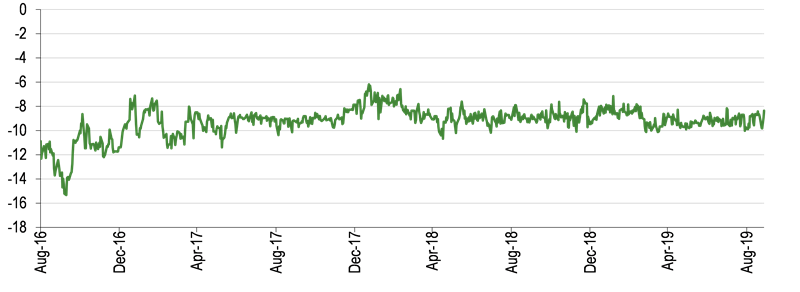
Exhibit 8: Share price discount to NAV (including income) over three years (%)
Capital structure and fees
SCIN is a conventional investment trust with a single share class; at 27 September 2019, there were 73.9m ordinary shares in issue. Shares are bought back regularly (up to an annual limit of 14.99% of shares in issue) with the aim of keeping the share price discount to cum-income NAV, with debt at market value, to 9% or below. So far in FY19, 3.3m shares (4.2% of the share base at the start of the year) have been repurchased, at a cost of £26.2m. The trust is structurally geared via secured bonds, issued with a life of 30 years (maturing in 2030) with a fixed coupon of 5.75%. The book value of the debt at end-H119 was £83.9m, representing gross gearing of 12.4%. However, SCIN’s net gearing is currently zero (that is, the borrowing is offset by cash holdings) given the manager’s caution on the near-term outlook for markets.
As a self-managed investment trust, SCIN does not pay management fees. Total expenses for H119 (including staff costs, directors’ and professional fees) were £1.79m; while this was higher than in the comparable period last year, H118 included a refund of previously paid expenses, and the current-year figure is broadly similar to that in H117. SCIN’s ongoing charges figure of 0.49% makes it one of the lowest-cost funds in the AIC universe.
Dividend policy and record
With dividends paid quarterly, in May, August, November and February (twice yearly until end-FY17), SCIN aims to achieve annual dividend growth ahead of the rate of UK inflation. Regular dividends have grown for the past 35 consecutive years, and have often been supplemented by a special dividend, dependent on the level of portfolio income. Since FY17, the regular dividend has been substantially higher (20.0p in FY17 and 21.2p in FY18, compared with 13.5p in FY16), while special dividends have been lower (5.0p in FY17 and 4.0p in FY18, compared with 9.0p in FY16). So far in FY19, SCIN has paid two interim dividends of 5.3p, with a third interim payment of 5.3p due to be made on 1 November. The board has also guided that it expects to pay a final dividend at or above this level, leading to total regular dividends for the year of at least 21.2p (unchanged on FY18). Given the long record of year-on-year dividend growth and the aim of growing the regular dividend above inflation, it seems reasonable to expect that the total dividends for the year will be higher than this guidance, possibly supplemented from the trust’s robust revenue reserve (61.9p per share at end-H119). The revenue return per share in H119 was 12.89p, up from 10.89p in H118, suggesting that total portfolio income for the year may come in higher than in FY18. Based on the current share price and the FY18 total dividend, SCIN currently has a yield of 3.0%. We include the special dividend in the yield calculation because the trust has paid a special in five of the last six years, meaning we do not consider such payments to be exceptional.
Peer group comparison
SCIN is a constituent of the Association of Investment Companies’ Global sector, a diverse group containing some of the largest and longest-established investment trusts, many of which follow a more growth/momentum-focused strategy than SCIN. Because of this, as well as showing the AIC Global averages below, we present a selection of more value-orientated strategies, drawn from a number of sectors including the AIC Global, UK All Companies, UK Smaller Companies, UK Equity Income, Europe, and Flexible Investment categories. While the value-orientated funds have clearly underperformed the AIC Global sector over all periods shown (reflecting the historically wide performance differential between ‘growth’ and ‘value’ stocks), SCIN has beaten the average of the value peer group over one, three and five years on a NAV total return basis, and is in line over 10 years. Its ongoing charges are below the average of both groups, ranking joint-lowest in the ‘value’ peer group, and it does not charge a performance fee. SCIN’s discount to NAV is wider than the average for either group; unsurprisingly, given the out-of-favour nature of the underlying investments, the value funds trade on average at a much wider discount than the Global peer group. In common with a number of peers, SCIN is currently ungeared on a net basis. Its 3.0% dividend yield is above the average for the Global sector but a little below the average of the value peer group.
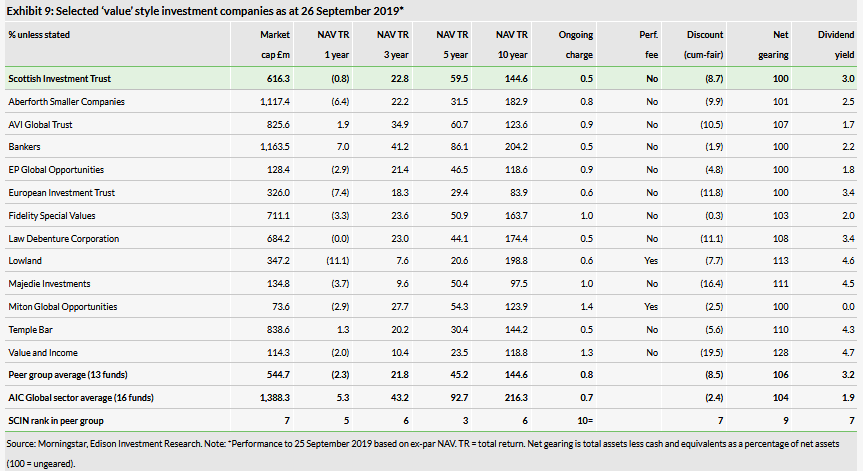
The board
SCIN currently has six independent, non-executive directors. The board is chaired by James Will, who became a director in 2013 and was appointed chairman in 2016. The longest-serving director is Russell Napier, appointed in 2009, who has indicated he plans to stand down at the February 2020 AGM. Jane Lewis and Mick Brewis both joined the board in 2015, while Karyn Lamont, chair of the audit committee, was appointed in 2017. The newest director, Neil Rogan, was appointed on 10 September 2019. The directors have professional backgrounds in corporate law, investment advice/analysis, corporate finance, fund management and accountancy.